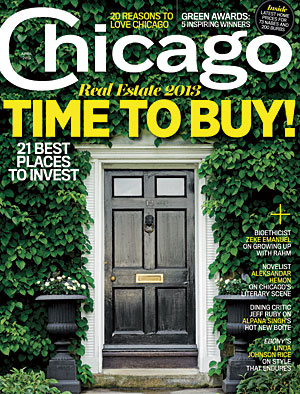
Some people who’ve been happy to welcome the recent signs of a real estate recovery here are going to get a little buzzkill from our annual charts on home values, which will be out soon in Chicago’s April issue. That’s because the charts track home values’ performance throughout 2012, a year whose early months saw us dipping the lowest we’ve been since the boom years but whose later months saw a slow, steady climb out of the hole.
It’s backward-looking data, not necessarily a gauge of what’s happening right now, a few months into what so far looks like a better year. Nevertheless, it’s solid data from an eminently reliable source, MRED LLC. So in the next few weeks, while I use this space to amplify what’s in the printed charts, please keep in mind that this isn’t an attempt to rain on anybody’s parade. It’s important to see this data, because it helps explain why so many homeowners are reluctant to sell and reinforces our understanding of the difference between the hot, hot real estate recovery in other areas and our lukewarm one.
More evidence of our tepid state came last week, when CoreLogic reported that while real estate values rose by 9.7% nationally during 2012, in the Chicago area, the improvement was just 0.6%.
The slow pace of recovery here is starkly visible on our charts, which show that only about 36% of the locations we track finished 2012 with prices higher than they were at the end of 2011. And many of those—such as Calumet Park and South Chicago Heights in the suburbs, and South Lawndale and West Garfield Park in the city—rose during the year largely because foreclosures were being bid up by investors and other buyers.
The comparison to 2006, the last full year of the boom, is even more disconcerting. Not a single suburb on the chart had home values higher at the end of 2012 than it had at the end of 2006. (Nor did any that we keep off the printed chart for having too few sales to make the calculations statistically significant.) In the city, where we use the traditional list of 77 neighborhoods, there are only three where 2012 house prices were above 2006: Kenwood, Near North, and North Center. And there are another three where condo prices crossed that line: Armour Square, the Loop and Lincoln Park.
Yet, 2006 is gone, and it falls farther and farther back in our rear view mirror the more time passes. In fact, the since-2006 picture did improve this past year: while our latest charts show six locations that are above their 2006 levels, last year at this time we were showing only three locations that could say so.
Another sign that 2006 and the later bottom in the market are beginning to fade into the background: many locations had home values that stayed flat in 2012. They didn’t spike upward, but they didn’t fall, either. About 19 percent of the suburbs and 10 percent of the city neighborhoods had median prices for 2012 that were within two percentage points above or below their 2011 figure. (Some people would take two-percent growth as healthy, and I’m not arguing with that; but many of these locations were way down the year before, so a change as small as two percent may not yet mean a lot.)
We’re still left with about half of our city neighborhoods and suburbs down two percent or more from 2011 at the end of 2012. That’s not pretty.
But one lesson that has consoled many homeowners in the nascent recovery is that price isn’t everything. The ability to move to a home that better suits your present lifestyle counts for a lot, and getting your house sold in a reasonably short length of time is a stress-buster. Next week, I’ll look at the charts’ evidence of a widespread speed-up in home sales. It’s a sure sign that in 2012, sellers around the region were doing what they had to do: kissing their 2006 prices goodbye and pointing toward tomorrow.
thumbnail photograph: michael tercha/chicago tribune


